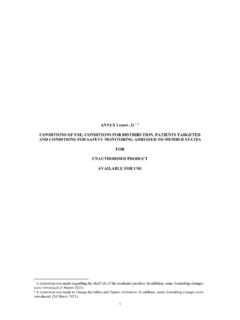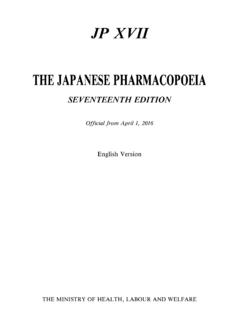Transcription of Zinc in Drinking-water - WHO
1 WHO/SDE/ onlyZinc in Drinking-waterBackground document for development ofWHO Guidelines for Drinking-water Quality_____Originally published in Guidelines for Drinking-water quality, 2nd ed. Vol. 2. Health criteria andother supporting information. World Health Organization, Geneva, 1996. World Health Organization 2003 All rights reserved. Publications of the World Health Organization can be obtained from Marketing andDissemination, World Health Organization, 20 Avenue Appia, 1211 Geneva 27, Switzerland (tel: +4122 791 2476; fax: +41 22 791 4857; email: for permission to reproduce or translate WHO publications - whether for sale or fornoncommercial distribution - should be addressed to Publications, at the above address (fax: +41 22791 4806; email: designations employed and the presentation of the material in this publication do not imply theexpression of any opinion whatsoever on the part of the World Health Organization concerning thelegal status of any country, territory, city or area or of its authorities, or concerning the delimitation ofits frontiers or mention of specific companies or of certain manufacturers products does not imply that they areendorsed or recommended by the World Health Organization in preference to others of a similar naturethat are not mentioned.))
2 Errors and omissions excepted, the names of proprietary products aredistinguished by initial capital World Health Organization does not warrant that the information contained in this publication iscomplete and correct and shall not be liable for any damages incurred as a result of its usePrefaceOne of the primary goals of WHO and its member states is that all people, whatevertheir stage of development and their social and economic conditions, have the right tohave access to an adequate supply of safe drinking water. A major WHO function toachieve such goals is the responsibility to propose regulations, and to makerecommendations with respect to international health matters .. The first WHO document dealing specifically with public Drinking-water quality waspublished in 1958 as International Standards for Drinking-water .
3 It was subsequentlyrevised in 1963 and in 1971 under the same title. In 1984 1985, the first edition of theWHO Guidelines for Drinking-water quality (GDWQ) was published in threevolumes: Volume 1, Recommendations; Volume 2, Health criteria and othersupporting information; and Volume 3, Surveillance and control of communitysupplies. Second editions of these volumes were published in 1993, 1996 and 1997,respectively. Addenda to Volumes 1 and 2 of the second edition were published in1998, addressing selected chemicals. An addendum on microbiological aspectsreviewing selected microorganisms was published in GDWQ are subject to a rolling revision process. Through this process, microbial,chemical and radiological aspects of Drinking-water are subject to periodic review,and documentation related to aspects of protection and control of public Drinking-water quality is accordingly the first edition of the GDWQ, WHO has published information on healthcriteria and other supporting information to the GDWQ, describing the approachesused in deriving guideline values and presenting critical reviews and evaluations ofthe effects on human health of the substances or contaminants examined in each chemical contaminant or substance considered, a lead institution prepared ahealth criteria document evaluating the risks for human health from exposure to theparticular chemical in Drinking-water .
4 Institutions from Canada, Denmark, Finland,France, Germany, Italy, Japan, Netherlands, Norway, Poland, Sweden, UnitedKingdom and United States of America prepared the requested health the responsibility of the coordinators for a group of chemicals considered in theguidelines, the draft health criteria documents were submitted to a number ofscientific institutions and selected experts for peer review. Comments were taken intoconsideration by the coordinators and authors before the documents were submittedfor final evaluation by the experts meetings. A final task force meeting reviewed thehealth risk assessments and public and peer review comments and, where appropriate,decided upon guideline values. During preparation of the third edition of the GDWQ,it was decided to include a public review via the world wide web in the process ofdevelopment of the health criteria the preparation of health criteria documents and at experts meetings, carefulconsideration was given to information available in previous risk assessments carriedout by the International Programme on Chemical Safety, in its Environmental HealthCriteria monographs and Concise International Chemical Assessment Documents, theInternational Agency for Research on Cancer, the joint FAO/WHO Meetings onPesticide Residues, and the joint FAO/WHO Expert Committee on Food Additives(which evaluates contaminants such as lead, cadmium, nitrate and nitrite in addition tofood additives).
5 Further up-to-date information on the GDWQ and the process of their development isavailable on the WHO internet site and in the current edition of the work of the following coordinators was crucial in the development of this backgrounddocument for development of WHO Guidelines for Drinking-water Fawell, Water Research Centre, United Kingdom (inorganic constituents)U. Lund, Water Quality Institute, Denmark (organic constituents and pesticides)B. Mintz, Environmental Protection Agency, USA (disinfectants and disinfectant by-products)The WHO coordinators were as follows:Headquarters:H. Galal-Gorchev, International Programme on Chemical SafetyR. Helmer, Division of Environmental HealthRegional Office for Europe:X. Bonnefoy, Environment and HealthO. Espinoza, Environment and HealthMs Marla Sheffer of Ottawa, Canada, was responsible for the scientific editing of the efforts of all who helped in the preparation and finalization of this document, includingthose who drafted and peer reviewed drafts, are gratefully convening of the experts meetings was made possible by the financial support afforded to WHO bythe Danish International Development Agency (DANIDA), Norwegian Agency for DevelopmentCooperation (NORAD), the United Kingdom Overseas Development Administration (ODA) and theWater Services Association in the United Kingdom, the Swedish International Development Authority(SIDA), and the following sponsoring countries.
6 Belgium, Canada, France, Italy, Japan, Netherlands,United Kingdom of Great Britain and Northern Ireland and United States of DESCRIPTIONI dentityZinc occurs in small amounts in almost all igneous rocks. The principal zinc ores are sulfides, such assphalerite and wurzite (1). The natural zinc content of soils is estimated to be 1 300 mg/kg (2).Physicochemical propertiesPropertyValuePhysical stateBluish-white metalMelting CBoiling point907 CDensity (g/cm3) at 20 COrganoleptic propertiesZinc imparts an undesirable astringent taste to water. Tests indicate that 5% of a population coulddistinguish between zinc-free water and water containing zinc at a level of 4 mg/litre (as zinc sulfate).The detection levels for other zinc salts were somewhat higher. Water containing zinc at concentrations inthe range 3 5 mg/litre also tends to appear opalescent and develops a greasy film when boiled (3).
7 Major usesZinc is used in the production of corrosion-resistant alloys and brass, and for galvanizing steel and ironproducts. Zinc oxide, used in rubber as a white pigment, for example, is the most widely used zinccompound. Peroral zinc is occasionally used to treat zinc deficiency in humans. Zinc carbamates are usedas pesticides (1).ANALYTICAL METHODSA tomic absorption spectrophotometry is the most widely used method for the determination of zinc. Thedetection limit of the direct air acetylene flame method is 50 g/litre (4). Low concentrations can bemeasured by chelating zinc with ammonium pyrrolidine dithiocarbamate and extracting it with methylisobutyl ketone (detection limit 1 g/litre) (5).ENVIRONMENTAL LEVELS AND HUMAN EXPOSUREAirIn rural areas, atmospheric zinc concentrations are typically between 10 and 100 ng/m3, whereas levels inurban areas commonly fall within the range 100 500 ng/m3 (2).
8 Mean concentrations of zinc associatedwith particulate matter in ambient air in Canada were 85 ng/m3 (6) and in Finland, 170 ng/m3 (7).WaterIn natural surface waters, the concentration of zinc is usually below 10 g/litre, and in groundwaters, 10 40 g/litre (1). In tapwater, the zinc concentration can be much higher as a result of the leaching of zincfrom piping and fittings (2). The most corrosive waters are those of low pH, high carbon dioxide content,and low mineral salts content. In a Finnish survey of 67% of public water supplies, the median zinccontent in water samples taken upstream and downstream of the waterworks was below 20 g/litre; muchhigher concentrations were found in tapwater, the highest being mg/litre (8). Even higher zincconcentrations (up to 24 mg/litre) were reported in a Finnish survey of water from almost 6000 wells (9).
9 2 FoodProtein-rich foods, such as meat and marine organisms, contain high concentrations of zinc (10 50 mg/kgwet weight), whereas grains, vegetables, and fruit are low in zinc (usually <5 mg/kg) (1).Estimated total exposure and relative contribution of drinking-waterValues of 5 22 mg have been reported in studies on the average daily intake of zinc in different areas (1).The zinc content of typical mixed diets of North American adults varies between 10 and 15 mg/day (10).In Finland, the average daily intake of zinc from foodstuffs is calculated to be 16 mg (11). Therecommended dietary allowance for adult men is set at 15 mg/day, for adult women 12 mg/day, forformula-fed infants 5 mg/day, and for preadolescent children 10 mg/day (12,13). Drinking-water usually makes a negligible contribution to zinc intake unless high concentrations of zincoccur as a result of corrosion of pipings and fittings.
10 Under certain circumstances, tapwater can provideup to 10% of the daily intake (9,14).KINETICS AND METABOLISM IN LABORATORY ANIMALS AND HUMANSA bsorption of ingested zinc is highly variable (10 90%) and is affected by a number of mechanisms exist for the gastrointestinal absorption and excretion of zinc. High zincconcentrations are found in prostate, bone, muscle, and liver. Excretion takes place mainly (75%) via thegastrointestinal tract, and only to a smaller extent via urine and sweat. The biological half-time of retainedzinc in humans is of the order of 1 year (1).Zinc is an essential element in all living organisms. Nearly 200 zinc-containing enzymes have beenidentified, including many dehydrogenases, aldolases, peptidases, polymerases, and phosphatases (15).EFFECTS ON LABORATORY ANIMALS AND IN VITRO TEST SYSTEMSA cute exposureAcute oral LD50 values in rats are reported to be as follows: zinc chloride 350, zinc sulfate 2949, and zincethanoate 2510 mg/kg of body weight (16).












